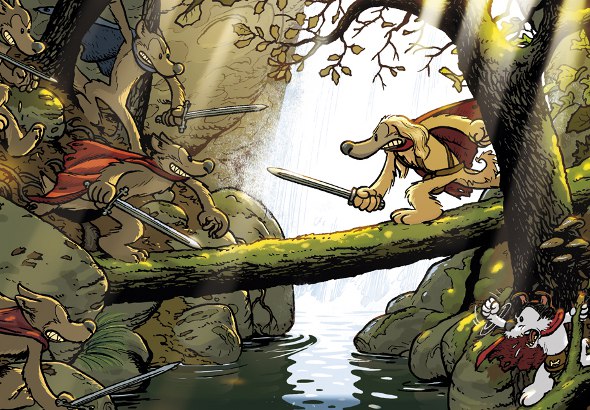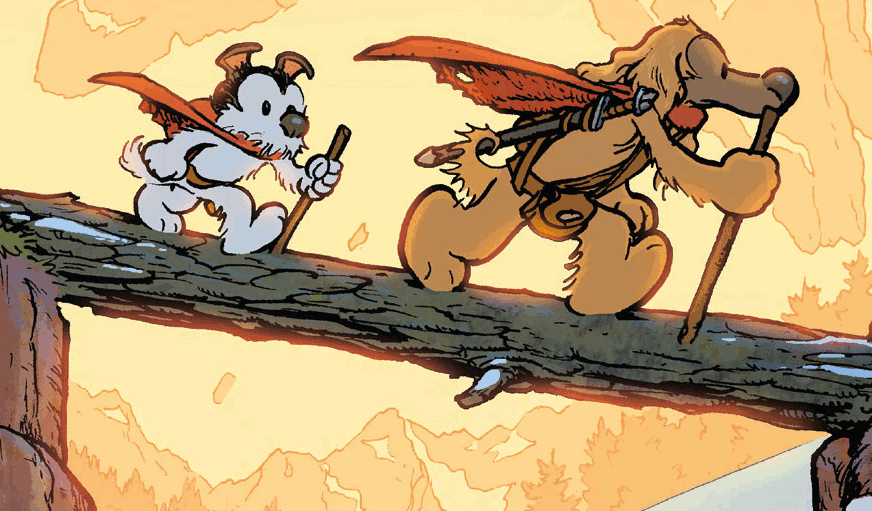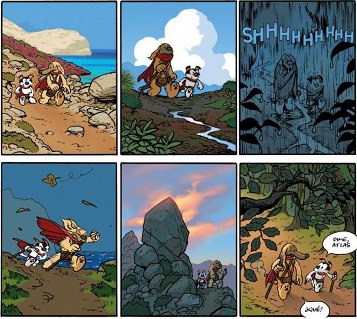Review: 'La Saga d'Atlas & Axis', volumes 1 & 2, by Pau
My thanks to Lex Nakashima for ordering these albums from France and loaning them to me.

There was an announcement for these two albums on Flayrah in February. Then I did not know any more about them than I could find out online, on Ankama’s own website and on Amazon.fr. They looked good. Now that I have seen them, I can say that they look excellent; worth buying for the art even if you cannot read the French text.
“La Saga d’Atlas & Axis”, tome 1, by Pau.
Roubaix, France, Ankama Éditions, Aug. 2011, hardcover €14.90 (74 [+ 6] pages; on Amazon).
“La Saga d’Atlas & Axis”, tome 2, by Pau.
Roubaix, France, Ankama Éditions, Feb. 2013, hardcover €14.90 (74 [+ 6] pages; on Amazon).

 Allow me to reprint my translation of the publisher’s blurb for the first volume:
Allow me to reprint my translation of the publisher’s blurb for the first volume:
In the world of Pongeo, where all the animals talk and walk on two paws, Atlas and Axis are two mutts of very different characters and pedigrees: the first is intelligent and rational, while the second is controlled more by his feelings. One day when the two companions return to their village for a festival, they discover it ravaged by the cruel Vikiens, bloody brutes from the North who pillage and kill all who fall under their claws. So begins the saga of Atlas and Axis, the astonishing epic of two friends overflowing with courage, who leave to brave the great North to avenge their folk. In the grand tradition of adventuring duos, prepare to live a story funny and terrible, tender and epic …
I said that “Their world looks like a doggy version of Astérix & Obélix …”, and that is still a good comparison, except that there are many more anthropomorphized animals than just dogs. The setting looks like northern France in the 9th or 10th centuries, when the Vikings were just beginning their raids and settlements that would lead to Celtic Armorica being renamed Normandy. I said that Atlas is a golden retriever, and he does look like one in Pau’s art style, but the dialogue establishes him as an Afghan hound. Axis is a terrier, or a mongrel about that size. Atlas is the more intelligent and careful of the pair, while Axis tends to rush into things.
Two major differences from the Astérix & Obelix series are that, despite its humor, this is a much darker tale; and, based on the first two volumes, this is a single continuing serial rather than a collection of separate stories.
Atlas and Axis are Celt-like warriors who live near the small village of Kanina. The story begins with Atlas’ return from a journey to get an old manuscript for their wizard, Canuto.
Axis: “Don’t tell me that you’re back already with the parchment for Canuto?”
Atlas: “Its translation, yes. … All I know is that Canuto needs it for his research into a legend about a magic bone.”
… “The legend says that whoever finds it will possess the endlessly overflowing bowl of Khimera.”
Atlas has hurried home to be in time for Kanina’s festival. Axis is looking forward to it because he’s in love with Atlas’ sister, Erika. But when they travel the couple of miles to Kanina, they find the village burnt down and vultures eating the corpses of their friends.
Only Canino is still alive, mortally wounded. He tells them that the village was destroyed by a ship of large white dogs or wolves from the north. “The ship was black with a red sail … Argh! Their capes … were fastened with clips like this …” He holds up a bloody metal clip in the shape of the symbol on the pirates’ sail, and dies.
Atlas and Axis bury their slain neighbors, and realize that the bodies of Erika and her best friend, the vixen Raposa, are missing. The two warriors were already determined to avenge Kanina; now they have the hope of saving Erika and Raposa as well. So begins a journey of vengeance and rescue to the Far North, during which Atlas falls in love with Mika, a widow whose husband was also killed by the pirates. She tells him that they are the Vikiens, wolf sea raiders from the North. This band is led by a huge polar bear warrior. The rest is a bloody saga of two warriors against a Vikien village of wolf warriors and their polar bear chieftan. A character whom they meet who returns in volume 2 is Miel (Honey), the motherly bear innkeeper of the Bar of the Tower.

The world of Pongeo is much more animalistic than the standard funny animal setting. Atlas and Axis mark their territory as dogs do. When they find Kanina destroyed and vultures eating the bodies of their friends, the vultures jovially invite them to join the feast (dogs do eat carrion) and are indignant when they insist on burying the bodies. Male dogs refer to their girlfriends and wives as bitches, and to their children as puppies. Atlas and Axis do not hesitate to kill and eat herbivore peasants like rabbits and sheep who are as intelligent as they are. A scene of two dogs making love is halfway between human and canine.  And, unlike our world, sheep explode when they die. Sheep suicidal terrorists take advantage of this.
And, unlike our world, sheep explode when they die. Sheep suicidal terrorists take advantage of this.
In volume 2, the two dog warriors have succeeded in their mission of vengeance but, with their village destroyed and all of their friends killed, they have nothing to return to. They settle at Miel’s tavern, paying by bringing in fresh-killed food every day. But after only a couple of days, they can’t help overhearing a noisy argument between two traveling scholars. The older claims that dogs are evolved from wolves, while the other insists that dogs were created by the god Toby in his own image. The believer in evolution offers to outfit Atlas and Axis for an expedition to bring back proof of the Tarses, a legendary missing link tribe halfway between wolves and dogs, which incidentally is connected to the magic bowl of Khimera. The quest leads to what is clearly central Asia, a canine Genghis Khan, and living mammoths and dinosaurs. The volume ends with Atlas and Axis impressed into a barbarian fleet en route to conquer a thinly-disguised Constantinople. Obviously the story is to be continued.
Le Saga d’Atlas & Axis is written and drawn by Jean-Marc Pau, a cartoonist from Majorca. (It is published in French; Pau has a blog, in Spanish.) Each volume is 74 pages, as opposed to the usual French bande dessinée album of 48 pages. The French is textbook-easy to translate; no slang or dialect. There are a few ingroup references, such as a rabbit peasant named Oswald. Since America seems to have given up on anthropomorphic animal comic books, try the French – and you can’t do much better than La Saga d’Atlas & Axis.
Read more: An interview with Jean-Marc Pau
About the author
Fred Patten — read stories — contact (login required)a retired former librarian from North Hollywood, California, interested in general anthropomorphics
Comments
Post new comment